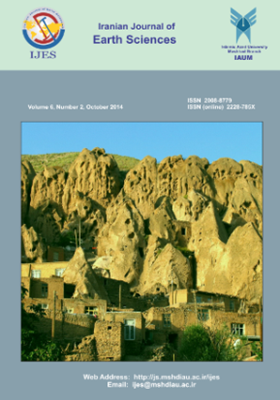Landslide Risk Assessment for Baba Heydar Watershed, Chaharmahal and Bakhtiari Province, Iran
محورهای موضوعی : MineralogyEbrahim Karimi Sangchini 1 , Abdolhossein Arami 2 , Hasan Rezaii Moghadam 3 , Zainab Khodabakhshi 4 , Roya Jafari 5
1 - Ph.D student of Watershed Management, Gorgan University of Agricultural Sciences and Natural Resources, Iran
2 - Ph.D Student of Arid Zone Management, Gorgan University of Agricultural Sciences and Natural Resources, Iran
3 - M. Sc student of Watershed Management, Gorgan University of Agricultural Sciences and Natural Resources, Iran
4 - M.sc Graduate of Sedimentology and Sedimentary Petrology Islamic Azad University, Khorasgan Branch, Iran
5 - M. Sc student of Watershed Management, Gorgan University of Agricultural Sciences and Natural Resources, Iran
کلید واژه: Risk, Vulnerability, landslide hazard, element at risk, Baba Heydar Watershed, Chaharmahal and Bakhtiari province,
چکیده مقاله :
Landslides are among the most damaging natural hazards in mountainous regions. In this study, landslide hazard zonation was conducted in the Baba Heydar Watershed using logistic statistical regression to determine landslide hazard areas. First, a landslide inventory map was prepared using aerial photograph interpretation and field surveys. Next, ten landslide conditioning factors including altitude, slope percentage, slope aspect, lithology, distance from faults, streams, villages and roads, land use, and precipitation were chosen as effective factors on landslide occurrence in the study area. Then, a landslide susceptibility map was constructed using a logistic regression statistical model in a geographic information system (GIS). Relative Operating Characteristics (ROC) and Pseudo R2 indices were used for model assessment. Finally, a risk map was created based on a risk equation using a combination of the susceptibility map, elements at risk and vulnerability. Results showed that the logistic regression statistical model provided slightly higher prediction accuracy of landslide susceptibility in the Baba Heydar Watershed with ROC equal to 0.876. The results revealed that about 44% of the watershed area was located in both the high and very high hazard classes. Additionally, 35% of the surveyed watershed was located in the high and very high-risk classes. This information is critical for the risk management, landslide risk and land planning of this mountainous area..
Landslides are among the most damaging natural hazards in mountainous regions. In this study, landslide hazard zonation was conducted in the Baba Heydar Watershed using logistic statistical regression to determine landslide hazard areas. First, a landslide inventory map was prepared using aerial photograph interpretation and field surveys. Next, ten landslide conditioning factors including altitude, slope percentage, slope aspect, lithology, distance from faults, streams, villages and roads, land use, and precipitation were chosen as effective factors on landslide occurrence in the study area. Then, a landslide susceptibility map was constructed using a logistic regression statistical model in a geographic information system (GIS). Relative Operating Characteristics (ROC) and Pseudo R2 indices were used for model assessment. Finally, a risk map was created based on a risk equation using a combination of the susceptibility map, elements at risk and vulnerability. Results showed that the logistic regression statistical model provided slightly higher prediction accuracy of landslide susceptibility in the Baba Heydar Watershed with ROC equal to 0.876. The results revealed that about 44% of the watershed area was located in both the high and very high hazard classes. Additionally, 35% of the surveyed watershed was located in the high and very high-risk classes. This information is critical for the risk management, landslide risk and land planning of this mountainous area..


